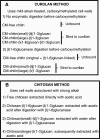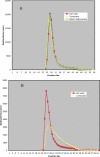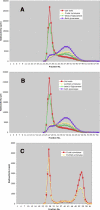Two novel techniques for determination of polysaccharide cross-links show that Crh1p and Crh2p attach chitin to both beta(1-6)- and beta(1-3)glucan in the Saccharomyces cerevisiae cell wall
- PMID: 19734368
- PMCID: PMC2772413
- DOI: 10.1128/EC.00228-09
Two novel techniques for determination of polysaccharide cross-links show that Crh1p and Crh2p attach chitin to both beta(1-6)- and beta(1-3)glucan in the Saccharomyces cerevisiae cell wall
Abstract
Previous work, using solubilization of yeast cell walls by carboxymethylation, before or after digestion with beta(1-3)- or beta(1-6)glucanase, followed by size chromatography, showed that the transglycosylases Crh1p and Crh2p/Utr2p were redundantly required for the attachment of chitin to beta(1-6)glucan. With this technique, crh1Delta crh2Delta mutants still appeared to contain a substantial percentage of chitin linked to beta(1-3)glucan. Two novel procedures have now been developed for the analysis of polysaccharide cross-links in the cell wall. One is based on the affinity of curdlan, a beta(1-3)glucan, for beta(1-3)glucan chains in carboxymethylated cell walls. The other consists of in situ deacetylation of cell wall chitin, generating chitosan, which can be extracted with acetic acid, either directly (free chitosan) or after digestion with different glucanases (bound chitosan). Both methodologies indicated that all of the chitin in crh1Delta crh2Delta strains is free. Reexamination of the previously used procedure revealed that the beta(1-3)glucanase preparation used (zymolyase) is contaminated with a small amount of endochitinase, which caused erroneous results with the double mutant. After removing the chitinase from the zymolyase, all three procedures gave coincident results. Therefore, Crh1p and Crh2p catalyze the transfer of chitin to both beta(1-3)- and beta(1-6)glucan, and the biosynthetic mechanism for all chitin cross-links in the cell wall has been established.
Figures






Similar articles
-
Crh1p and Crh2p are required for the cross-linking of chitin to beta(1-6)glucan in the Saccharomyces cerevisiae cell wall.Mol Microbiol. 2007 Feb;63(3):921-35. doi: 10.1111/j.1365-2958.2006.05565.x. Mol Microbiol. 2007. PMID: 17302808
-
Presence of a large β(1-3)glucan linked to chitin at the Saccharomyces cerevisiae mother-bud neck suggests involvement in localized growth control.Eukaryot Cell. 2012 Apr;11(4):388-400. doi: 10.1128/EC.05328-11. Epub 2012 Feb 24. Eukaryot Cell. 2012. PMID: 22366124 Free PMC article.
-
Assembly of the yeast cell wall. Crh1p and Crh2p act as transglycosylases in vivo and in vitro.J Biol Chem. 2008 Oct 31;283(44):29859-72. doi: 10.1074/jbc.M804274200. Epub 2008 Aug 11. J Biol Chem. 2008. PMID: 18694928 Free PMC article.
-
Biosynthesis of cell wall and septum during yeast growth.Arch Med Res. 1993 Autumn;24(3):301-3. Arch Med Res. 1993. PMID: 8298281 Review.
-
Cell Surface Interference with Plasma Membrane and Transport Processes in Yeasts.Adv Exp Med Biol. 2016;892:11-31. doi: 10.1007/978-3-319-25304-6_2. Adv Exp Med Biol. 2016. PMID: 26721269 Review.
Cited by
-
In Vitro and In Vivo Studies on the Structural Organization of Chs3 from Saccharomyces cerevisiae.Int J Mol Sci. 2017 Mar 25;18(4):702. doi: 10.3390/ijms18040702. Int J Mol Sci. 2017. PMID: 28346351 Free PMC article.
-
Proteins involved in building, maintaining and remodeling of yeast cell walls.Curr Genet. 2013 Nov;59(4):171-85. doi: 10.1007/s00294-013-0403-0. Curr Genet. 2013. PMID: 23959528
-
Unlocking the Potential of the Antimicrobial Peptide Gomesin: From Discovery and Structure-Activity Relationships to Therapeutic Applications.Int J Mol Sci. 2023 Mar 20;24(6):5893. doi: 10.3390/ijms24065893. Int J Mol Sci. 2023. PMID: 36982972 Free PMC article. Review.
-
Characterization of an antifungal β-1,3-glucanase from Ficus microcarpa latex and comparison of plant and bacterial β-1,3-glucanases for fungal cell wall β-glucan degradation.Planta. 2023 Nov 9;258(6):116. doi: 10.1007/s00425-023-04271-4. Planta. 2023. PMID: 37946063
-
Glucanase-Induced Stipe Wall Extension Shows Distinct Differences from Chitinase-Induced Stipe Wall Extension of Coprinopsis cinerea.Appl Environ Microbiol. 2019 Oct 16;85(21):e01345-19. doi: 10.1128/AEM.01345-19. Print 2019 Nov 1. Appl Environ Microbiol. 2019. PMID: 31444203 Free PMC article.
References
-
- Allan, G. G., and M. Peyron. 1995. Molecular weight manipulation of chitosan. I. Kinetics of depolymerization by nitrous acid. Carbohydr. Res. 277:257-272. - PubMed
-
- Araki, Y., and E. Ito. 1975. A pathway of chitosan formation in Mucor rouxii. Enzymatic deacetylation of chitin. Eur. J. Biochem. 55:71-78. - PubMed
-
- Bom, I. J., S. K. Dielbandhoesing, K. N. Harvey, S. J. C. M. Oomes, F. M. Klis, and S. Brul. 1998. A new tool for studying the molecular architecture of the fungal cell wall: one step purification of recombinant Trichoderma β-(1-6)-glucanase expressed in Pichia pastoris. Biochim. Biophys. Acta 1425:419-424. - PubMed
-
- Cabib, E., and A. Durán. 2005. Synthase III-dependent chitin is bound to different acceptors depending on location on the cell wall of budding yeast. J. Biol. Chem. 280:9170-9179. - PubMed
-
- Cabib, E., B. Bowers, A. Sburlati, and S. J. Silverman. 1988. Fungal cell wall synthesis: the construction of a biological structure. Microbiol. Sci. 5:370-375. - PubMed
Publication types
MeSH terms
Substances
Grants and funding
LinkOut - more resources
Full Text Sources
Molecular Biology Databases

